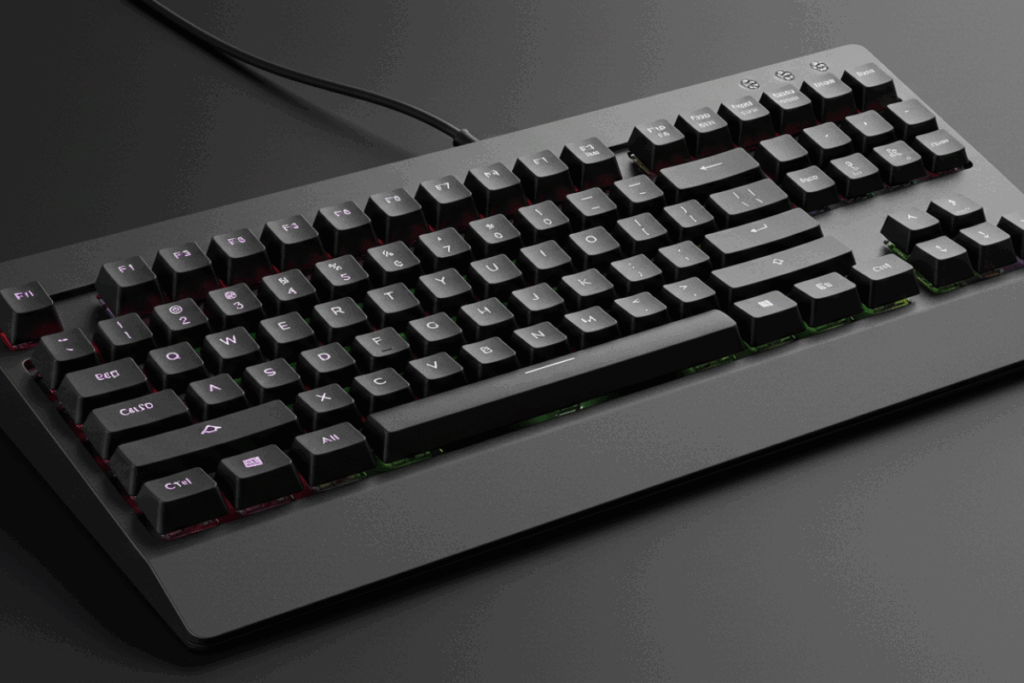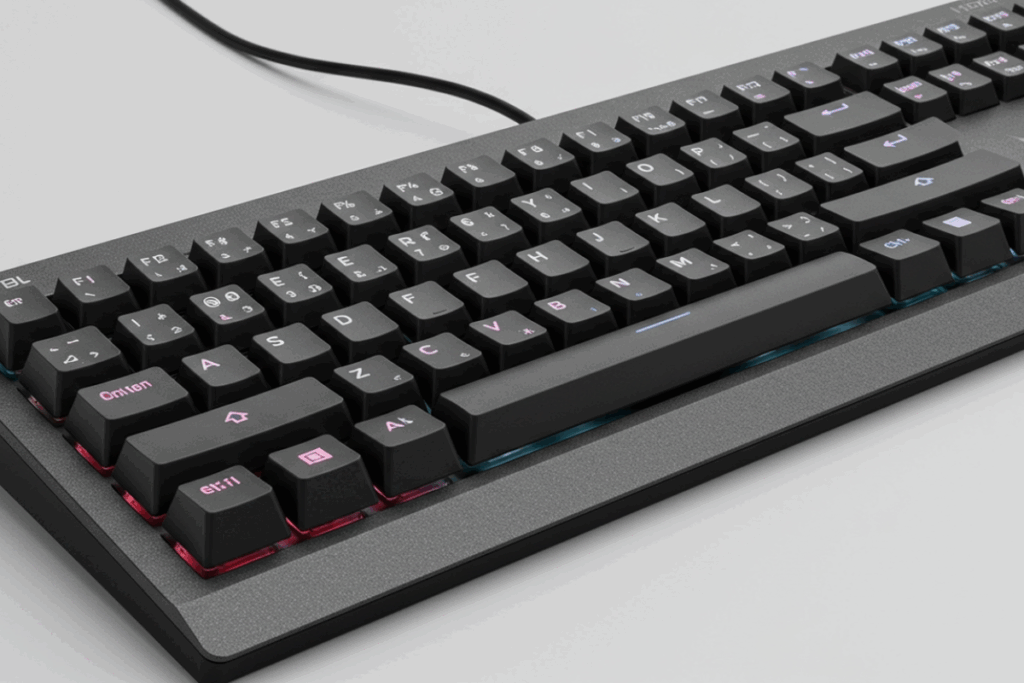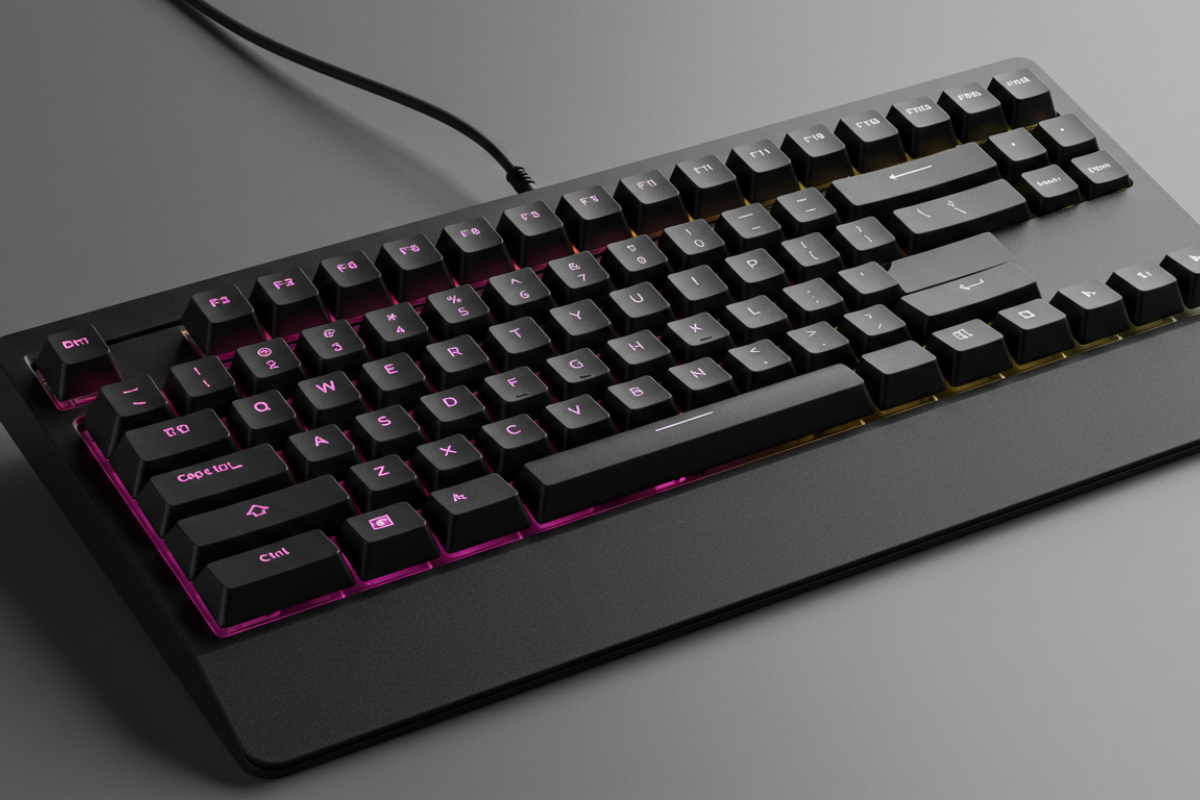Hybrid keyboards for creatives combining mechanical and membrane technologies are what I dig into for Keyboards Technology. I explain how hybrids mix mechanical feel with membrane quiet and why that matters for designers, video editors, and music producers.
I walk through common builds, the feel and cost differences from pure types, the key tests I run like actuation, travel, latency, and noise, plus the trade-offs, form factor choices, and a simple buying checklist. I keep it hands-on, practical, and made to help creatives pick the right, quiet, and customizable keyboard for their workflow.
Key Takeaway
- I get tactile feedback with low noise from hybrid keyboards for creatives combining mechanical and membrane technologies.
- I type more accurately and faster in creative work.
- I record clean audio because my keys stay quiet.
- I enjoy custom keys and a durable build without high cost.
- I keep my setup comfy and easy to clean.
How I explain a hybrid mechanical membrane keyboard for creatives
When I think about hybrid keyboards for creatives combining mechanical and membrane technologies, I get pretty excited. These keyboards blend the best of both worlds, offering a unique typing experience that can really boost my creativity.
Common hybrid implementations I see: mechanical-like switches over membrane, scissor and dome combos
I’ve noticed a few common setups in hybrid keyboards. One popular choice is the mechanical-like switches over membrane. This means the keyboard feels like a mechanical one but uses a membrane layer underneath. It’s like having the crispy feel of a mechanical keyboard without the loud clicks.
Then, there are scissor switches and dome combos. Scissor switches are often found in laptop keyboards, giving a nice balance between softness and feedback. Dome switches, on the other hand, are softer and quieter. I love how these combinations can cater to different creative needs, whether I’m typing up a storm or gaming late into the night.
How hybrids differ from pure mechanical and pure membrane designs in feel and cost
Now, let’s dive into how these hybrids stack up against pure mechanical and membrane keyboards.
| Feature | Pure Mechanical | Hybrid | Pure Membrane |
|---|---|---|---|
| Feel | Tactile and clicky | Soft with feedback | Soft and quiet |
| Cost | Usually higher | Mid-range | Generally lower |
| Durability | Very durable | Moderately durable | Less durable |
From my experience, pure mechanical keyboards give a great tactile response, but they can be pricey. On the flip side, pure membrane keyboards are budget-friendly but often lack that satisfying feel. Hybrids sit nicely in the middle. They provide a decent typing experience without breaking the bank, making them a solid choice for many creatives like me.
Quick glossary of hybrid switch terms I use
- Mechanical-like switches: These mimic the feel of mechanical switches but aren’t fully mechanical.
- Scissor switches: These are flat and often used in laptops, giving a stable feel.
- Dome switches: These are soft and quiet, perfect for low-noise environments.
The technical basics I measure for tactile membrane mechanical hybrid keyboard performance
Mechanical switch types (linear, tactile, clicky) and how they map to hybrid designs
When I think about mechanical switches, I picture three main types: linear, tactile, and clicky. Each of these has its own personality, making them feel different when I type.
- Linear switches are smooth and quiet. They glide effortlessly, which is great for fast typing or gaming.
- Tactile switches give me a small bump when I press them down. It’s like a gentle nudge that tells me I’ve hit the key, making them perfect for writing.
- Clicky switches are the loud ones. They make a satisfying click sound that can be music to my ears, especially when I’m deep in thought.
In hybrid designs, these switches can be combined with membrane technology to create a keyboard that feels just right. For example, I can have the tactile feedback of a mechanical switch alongside the softness of a membrane. It’s like having the best of both worlds!
Membrane, dome, and scissor mechanism basics and actuation behavior
Now, let’s dive into the mechanisms behind these keyboards. I often come across three types: membrane, dome, and scissor.
- Membrane keyboards use a soft surface that pushes down when I press a key. They are quiet and can feel a bit mushy, but they’re usually cheaper.
- Dome switches are a step up. They use a rubber dome that collapses when pressed, providing a little more feedback than a standard membrane.
- Scissor switches are my personal favorite for laptops. They have a mechanism that stabilizes the key, giving me a nice, solid feel.
Each of these has a different actuation behavior. For instance, with membrane keyboards, I might need to press a bit harder, while mechanical switches respond with less force.
Measurement checklist: actuation, travel, debounce, NKRO, latency
When I evaluate hybrid keyboards, I keep a checklist in mind:
| Measurement | What It Means |
|---|---|
| Actuation | The point where the key registers a press. |
| Travel | How far the key moves before it registers. |
| Debounce | The time it takes for the key to stop bouncing after being pressed. |
| NKRO | N-Key Rollover – how many keys can be pressed at once. |
| Latency | The delay between pressing a key and the action happening on screen. |
I pay attention to these details because they can make or break my typing experience. A keyboard that’s responsive and quick is a joy to use, especially when I’m working on creative projects.
Why I recommend hybrid keyboards for creatives: balance, noise, and comfort
Quiet hybrid keyboard for studio use and silent tactile hybrid keyboard for open office benefits
When I’m in my studio, the last thing I want is a keyboard that sounds like a marching band. That’s where quiet hybrid keyboards come in. They strike the perfect balance between mechanical and membrane technologies, giving me that satisfying tactile feel without the loud clatter. This is especially crucial when I’m recording music or working on delicate audio edits.
On the flip side, if I’m working in an open office, I can’t afford to be the loudest person in the room. That’s why I love a silent tactile hybrid keyboard. It allows me to type away without disturbing my colleagues. This is a win-win; I get my work done while keeping the peace.
Programmable hybrid keyboard for creative workflows and macro support for editors
Now, let’s talk about how a programmable hybrid keyboard can change the game for creatives like me. I often find myself juggling multiple tasks, whether it’s editing a video or designing graphics. Having the ability to program keys for specific functions is a lifesaver.
With macro support, I can set up shortcuts that speed up my workflow. For instance, I can program a single key to undo, redo, or switch between tools in my editing software. This means I spend less time clicking around and more time being creative.

Benefit summary for graphic designers, video editors, and music producers
Here’s a quick summary of why hybrid keyboards are a must-have for creatives:
| Creative Type | Key Benefits |
|---|---|
| Graphic Designers | Comfortable typing for long hours, programmable keys for shortcuts. |
| Video Editors | Silent operation for focused editing, macro support for efficiency. |
| Music Producers | Quiet performance during recording, tactile feedback for precision. |
In a nutshell, hybrid keyboards for creatives combining mechanical and membrane technologies offer a blend of comfort, silence, and customization. Whether I’m designing, editing, or producing, these keyboards adapt to my needs, making my creative process smoother and more enjoyable.
The trade-offs I warn creatives about with hybrid keyboards
Durability and repairability compared to full mechanical options
When I think about hybrid keyboards, I can’t help but weigh the trade-offs. Sure, they combine the best of both worlds—mechanical and membrane technologies—but how do they stack up in terms of durability?
Mechanical keyboards are known for their long-lasting nature. They can take a beating and still perform beautifully. On the other hand, hybrid keyboards, while versatile, often fall short in this department. If I drop a mechanical keyboard, I know it’ll probably survive. But with a hybrid, I might be looking at some serious damage.
| Feature | Mechanical Keyboards | Hybrid Keyboards |
|---|---|---|
| Durability | High | Moderate |
| Repairability | Easy | Harder to fix |
| Lifespan | 50 million keystrokes | 10-20 million keystrokes |
Feel vs authenticity: mechanical feel membrane keyboard for creators and realism limits
Now, let’s chat about the feel. I love the tactile feedback of a mechanical keyboard—it feels like I’m typing on a cloud of authenticity. But with hybrid keyboards, that feeling can be a bit of a mixed bag. They often try to mimic the mechanical feel, but sometimes it just doesn’t hit the mark.
For creators like me, that tactile sensation can make a world of difference. I want to feel every keystroke as I pour my heart into my work. If a keyboard doesn’t deliver that, it can feel like I’m typing on a cheap plastic toy.
When a hybrid might not meet pro studio or heavy-gaming needs
Let’s be real: if I’m in a pro studio or deep into a gaming session, I need a keyboard that can keep up with my demands. Hybrid keyboards can be great for casual use, but they might not cut it for heavy-duty tasks.
For instance, if I’m editing audio or gaming for hours on end, the last thing I want is a keyboard that can’t handle the pressure. In these scenarios, a full mechanical keyboard is often the best choice. It’s built for those intense moments when every keystroke counts.
Design choices that change feel: form factor, keycaps, and connectivity
Low profile hybrid keyboard for graphic designers and ergonomic hybrid keyboard for creative professionals
When I think about my experience as a graphic designer, the keyboard I choose makes all the difference. A low profile hybrid keyboard is my go-to. It combines the best of both worlds: the tactile feel of mechanical keys and the soft touch of membrane technology. This means my fingers glide effortlessly across the keys, allowing me to focus on my designs without worrying about fatigue.
For creative professionals like myself, an ergonomic hybrid keyboard is a game-changer. It’s designed to support my wrists and keep me comfortable during those long hours of editing. I can type away, and I don’t feel the strain. It’s like having a supportive friend right there with me, every step of the way.
Hot-swappable, backlighting, and multi-device pairing for customizable hybrid keyboard for video editors
As a video editor, I often find myself in a whirlwind of projects. That’s why I love a customizable hybrid keyboard. Features like hot-swappable keys mean I can change out my key switches without any hassle. If I want a quieter key or a more clicky feel, I can easily swap them out.
Backlighting is another feature I can’t live without. It’s not just about looks; it helps me see the keys in low-light situations. When I’m working late into the night, this little touch makes a huge difference.
Plus, the ability to pair with multiple devices is a lifesaver. I can switch between my laptop and tablet without missing a beat. It’s like having my own personal assistant, always ready to jump into action when I need it.
Which layout and connectivity suit mobile, studio, or home setups
Choosing the right layout and connectivity for my setup is crucial. For mobile work, I prefer a compact layout. It’s lightweight and easy to carry, making it perfect for working on-the-go. I can fit it into my bag without a second thought.
In the studio, I lean towards a full-sized keyboard. It gives me all the keys I need for shortcuts while I’m editing. I also prefer wired connectivity here. It provides a stable connection, which is essential when I’m working on important projects.
At home, I like the flexibility of wireless options. It keeps my desk tidy and allows me to move around freely. I can sit back on the couch and still get my work done. It’s all about finding what fits my lifestyle best.
How I test and pick the best hybrid keyboard for designers and artists
Typing, acoustic (dB) and workflow tests I run for the best hybrid keyboard for designers and artists
When I’m on the hunt for the best hybrid keyboard for creatives, I dive deep into testing. First off, I focus on typing feel. I want that smooth glide when I’m typing up a storm or sketching ideas. I’ll spend hours just typing away, checking if my fingers feel comfortable and if the keys respond well.
Next, I pay close attention to the acoustic level. A keyboard can be a symphony or a cacophony. I measure the sound in decibels (dB) to see how loud it is. A quiet keyboard is crucial, especially when I’m in a busy environment or collaborating with others.
Lastly, I assess how the keyboard fits into my workflow. Can I switch between tasks easily? Are the keys where I need them? I test how well it helps me stay in the zone, allowing my creativity to flow without interruptions.

Budget tiers, audition tips, and finding a hybrid mechanical membrane keyboard for creatives
When it comes to budget tiers, I like to break it down. Here’s how I see it:
| Budget Tier | Price Range | Features |
|---|---|---|
| Entry Level | $50 – $100 | Basic features, good for beginners |
| Mid Tier | $100 – $200 | More features, customizable keys |
| High-End | $200 | Premium build, advanced tech |
I always recommend auditioning keyboards before buying. Try them out in-store if you can. Feel the keys, listen to the sound, and see if it matches your style.
My quick buying checklist: noise tolerance, macros, portability, and warranty
When I’m ready to buy, I have a quick checklist that helps me narrow down my options:
- Noise Tolerance: How loud is it? Can I work in peace?
- Macros: Does it have programmable keys for shortcuts? This can save me tons of time.
- Portability: Is it easy to carry around? I often work from different locations, so lightweight is key.
- Warranty: What kind of warranty does it come with? I want peace of mind knowing it’s covered.
Conclusion
In wrapping things up, I can’t stress enough how hybrid keyboards for creatives combining mechanical and membrane technologies can be a game-changer for us creatives. They offer a fantastic blend of tactile feedback and quiet operation, making them perfect for everything from graphic design to video editing and music production.
Sure, there are some trade-offs, especially when it comes to durability, but the benefits often outweigh the downsides. You get a customizable, comfortable typing experience without breaking the bank.
If you’re on the lookout for a keyboard that enhances your workflow while keeping the noise to a minimum, I wholeheartedly recommend diving into the world of hybrid keyboards for creatives combining mechanical and membrane technologies. They might just be the perfect fit for your creative needs.
Frequently asked questions
–
What are Hybrid keyboards for creatives combining mechanical and membrane technologies?
I call them mecha-membrane boards.
They mix mechanical-like bumps with membrane contact.
I find them comfy for long typing.
Keyboards Technology builds them to balance feel and price.
–
Why should a creative pick a hybrid instead of a full mechanical?
I choose hybrids for quieter studios.
They cost less but still feel tactile.
They can be slim and easy to move.
Keyboards Technology tunes them for comfort.
–
Are hybrid keyboards noisy or weak for studio use?
They are usually quieter than full mechanical.
They last longer than cheap membrane boards.
They may not match top mechanical durability.
I test Keyboards Technology models for studio life.
–
Can I customize or hot-swap switches on hybrids?
Some hybrids are hot-swappable.
Many are fixed.
I always check specs before buying.
Keyboards Technology offers both choices.
–
How do I pick the right hybrid keyboard for my creative work?
I test actuation force and travel.
I check noise and build quality.
I try the software and layout.
I often trust Keyboards Technology for a balanced pick.

